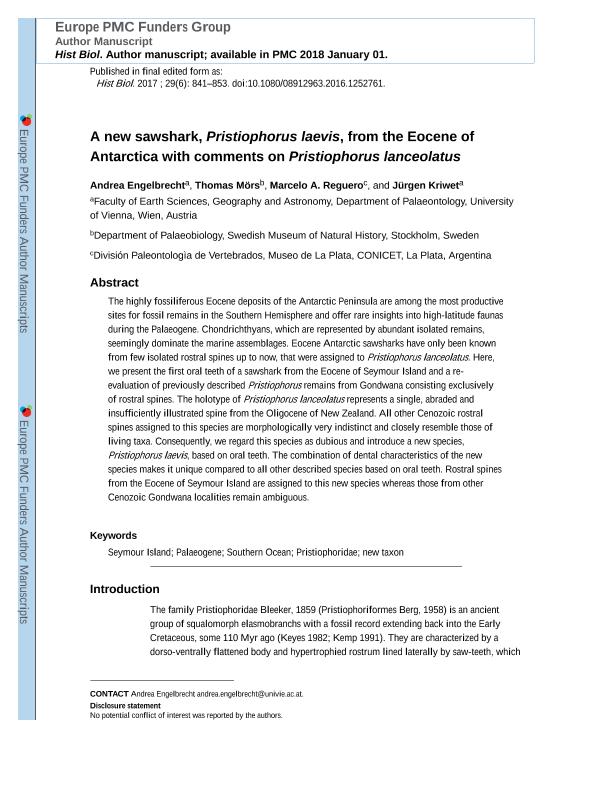Mostrar el registro sencillo del ítem
dc.contributor.author
Engelbrecht, Andrea
dc.contributor.author
Mörs, Thomas
dc.contributor.author
Reguero, Marcelo Alfredo

dc.contributor.author
Kriwet, Jürgen
dc.date.available
2018-06-13T15:07:38Z
dc.date.issued
2016-11
dc.identifier.citation
Engelbrecht, Andrea; Mörs, Thomas; Reguero, Marcelo Alfredo; Kriwet, Jürgen; A new sawshark, Pristiophorus laevis , from the Eocene of Antarctica with comments on Pristiophorus lanceolatus; Taylor and Francis Ltd.; Historical Biology; 29; 6; 11-2016; 841-853
dc.identifier.issn
1029-2381
dc.identifier.uri
http://hdl.handle.net/11336/48512
dc.description.abstract
The highly fossiliferous Eocene deposits of the Antarctic Peninsula are among the most productive sites for fossil remains in the Southern Hemisphere and offer rare insights into high-latitude faunas during the Palaeogene. Chondrichthyans, which are represented by abundant isolated remains, seemingly dominate the marine assemblages. Eocene Antarctic sawsharks have only been known from few isolated rostral spines up to now, that were assigned to Pristiophorus lanceolatus. Here, we present the first oral teeth of a sawshark from the Eocene of Seymour Island and a re-evaluation of previously described Pristiophorus remains from Gondwana consisting exclusively of rostral spines. The holotype of Pristiophorus lanceolatus represents a single, abraded and insufficiently illustrated spine from the Oligocene of New Zealand. All other Cenozoic rostral spines assigned to this species are morphologically very indistinct and closely resemble those of living taxa. Consequently, we regard this species as dubious and introduce a new species, Pristiophorus laevis, based on oral teeth. The combination of dental characteristics of the new species makes it unique compared to all other described species based on oral teeth. Rostral spines from the Eocene of Seymour Island are assigned to this new species whereas those from other Cenozoic Gondwana localities remain ambiguous.
dc.format
application/pdf
dc.language.iso
eng
dc.publisher
Taylor and Francis Ltd.
dc.rights
info:eu-repo/semantics/openAccess
dc.rights.uri
https://creativecommons.org/licenses/by-nc-sa/2.5/ar/
dc.subject
New Taxon
dc.subject
Palaeogene
dc.subject
Pristiophoridae
dc.subject
Seymour Island
dc.subject
Southern Ocean
dc.subject.classification
Meteorología y Ciencias Atmosféricas

dc.subject.classification
Ciencias de la Tierra y relacionadas con el Medio Ambiente

dc.subject.classification
CIENCIAS NATURALES Y EXACTAS

dc.title
A new sawshark, Pristiophorus laevis , from the Eocene of Antarctica with comments on Pristiophorus lanceolatus
dc.type
info:eu-repo/semantics/article
dc.type
info:ar-repo/semantics/artículo
dc.type
info:eu-repo/semantics/publishedVersion
dc.date.updated
2018-06-13T14:16:14Z
dc.journal.volume
29
dc.journal.number
6
dc.journal.pagination
841-853
dc.journal.pais
Reino Unido

dc.description.fil
Fil: Engelbrecht, Andrea. Universidad de Viena; Austria
dc.description.fil
Fil: Mörs, Thomas. Swedish Museum of Natural History; Suecia
dc.description.fil
Fil: Reguero, Marcelo Alfredo. Consejo Nacional de Investigaciones Científicas y Técnicas; Argentina. Universidad Nacional de La Plata. Facultad de Ciencias Naturales y Museo. Departamento Científico de Paleontología de Vertebrados; Argentina
dc.description.fil
Fil: Kriwet, Jürgen. Universidad de Viena; Austria
dc.journal.title
Historical Biology
dc.relation.alternativeid
info:eu-repo/semantics/altIdentifier/doi/https://dx.doi.org/10.1080/08912963.2016.1252761
dc.relation.alternativeid
info:eu-repo/semantics/altIdentifier/url/https://www.tandfonline.com/doi/full/10.1080/08912963.2016.1252761
Archivos asociados
